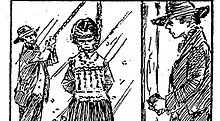Hannah OCuish (Intellectual disability)
Hannah Ocuish (sometimes "Occuish";4 March 1774 – December 20, 1786) was a 12-year old Pequot Native American girl.
with an intellectual disability who was hanged on December 20, 1786, in New London,
Connecticut for the murder of Eunice Bolles, the 6-year old daughter of a wealthy farmer.
She is believed to be the youngest person executed in the United States.In recent years,
Ocuish's guilt, culpability, and the fairness of her trial have come
Ledyard, Connecticut, U.S.
(Plot unknown)Known forYoungest person executed in United States history Criminal.
statusExecutedConviction(s)First-degree murde rCriminal penaltyDeathDetailsVictimsEunice Bolles, aged 6DateJuly 21, 1786
Early life.📌
Henry Channing, a minister, published a sermon entitled God Admonishing His People of their Duty ... a Sermon ... Occasioned by the Execution of Hannah Ocuish,
a Mixed Girl, Aged 12 Years and 9 Months, for the Murder of Eunice Bolles, Aged 6 Years and 6 Months.
It describes the negative light in which her early life was presented to the court, referring to her Native American mother as an "abandoned creature", and characterizing Ocuish as a fearsome violent criminal who at the age of 6 nearly killed another victim during a robbery of a gold necklace and clothing:
AS the Public may wish to be informed more particularly respecting the criminal,
Hannah Ocuish, than they have yet been: we have collected the following particulars,
which it may not be improper to annex as an appendix to the preceding discourse.
She was born at Groton.—Early in life she discovered the maliciousness and cruelty of her disposition: as appears from the following fact,
which was represented in evidence before the grand-jury. When about six years old, she with a brother about two years older than herself,
meeting a little girl at a distance from the neighbourhood, they endeavoured to get away her clothes and a gold necklace which she had on.
—After beating the child until they had almost killed her, they stripped her, and disputing about the division of the clothes the child recovered, and getting away came home, covered with blood.
This affair was immediately examined into, and the select-men of the town concluded to bind them both out.
Their mother, who is one of the Pequot tribe of indians, is an abandoned creature, much addicted to the vice of drunkenness.
—She, it seems, not liking to have the girl bound out; brought her away and left her at a house, about three miles from the city of New-London, promising to return in a few days and take her away again. But she did not return 'till after several months,
when urging the family to keep her longer they at length consented.—She continued in this family until she was apprehended for the crime,
for which she was executed.
Her conduct, as appeared in evidence before the honorable Superior Court was marked with almost every thing bad.
Theft and lying were her common vices. To these were added a maliciousness of disposition which made the children in the neighbourhood much afraid of her. She had a degree of artful cunning and sagacity beyond many of her years.
—In short, her mind wanted to be properly instructed, and her disposition to be corrected.
In modern US law, character evidence cannot be admitted to prove guilt.
According to FRE 404, "Evidence of a person’s character or character trait is not admissible to prove that on a particular occasion the person acted in accordance with the character or trait." Although a prosecutor may present the evidence for a different purpose, the trial judge must not consider it when determining guilt.
Muder.📌
The victim, six-year-old Eunice Bolles, the daughter of a wealthy farmer, was found dead on July 21, 1786.
Ocuish was questioned and said four boys were near the scene of the crime.
When the boys could not be found, the investigators further questioned her and she confessed.
Karen Halttunen, a history professor at the University of California at Davis, summarized the crime:
On the 21st of July, 1786, at about 10 o'clock in the morning, the body of the murdered child was found in the public road leading from New-London to Norwich,
lying on its face near to a wall ... The neighborhood turned out to hunt for the murderer;
Hannah was questioned and claimed that she had seen four boys near the scene of the crime. When a search failed to turn them up,
Hannah was interrogated again, and then taken to the Bolles home to be charged with homicide in the presence of the dead child. She burst into tears and confessed.
Only at this late point in the narrative is the reader offered a sequential account of the crime. Five weeks earlier,
Eunice had reported Hannah for stealing fruit during the strawberry harvest, and Hannah had plotted revenge.
Catching sight of her young enemy headed for school one morning, Hannah had lured Eunice from her path with a gift of calico, then beat and choked her to death.
Arrest.⛓
One day after the murder, Ocuish was accused of killing Bolles and confessed.
She was arrested for and charged with (indicted by a grand jury for) the murder and was held in pre-trial prison.
The murder was reported in the July 27, 1786, issue of the Norwich Packet.
The only inculpatory evidence against her was her confession to the investigators.
The confession was never corroborated by anyone besides the investigators.
The Fifth Amendment was not available at the time of the events.
Her confession reportedly includes baiting Bolles with calico, beating her nearly to death with a rock, strangling her to death, and placing rocks to stage an accident.
The confession specifies that the motive was that Bolles had earlier accused her of the theft of strawberries.
Trial. 🔗
During Ocuish's trial, she pleaded "not guilty" at the direction of defense counsel.
and seemed unfazed and calm as the rest of those present, including the presiding judge,
were brought to tears multiple times. The court found her guilty.
Sentencing.💔😢
Although Ocuish's youth was considered, it could not be a mitigating factor,
so the judge decided: "The sparing of you on account of your age would, as the law says,
be of dangerous consequence to the public, by holding up an idea, that children might commit such atrocious crimes with impunity."
He sentenced Ocuish to hang.Under the state of law at that time, age and disability were not mitigating factors: a reporter wrote,
"the age of a criminal was considered inconsequential; swift and relentless punishment was viewed as the only practicable method of keeping the lawless element in check."
Additionally, under the Murder Act 1752, a conviction of murder required a mandatory death penalty by hanging within 48 hours.
The Supreme Court deemed Capital punishment for juveniles in the United States unconstitutional in 2005 as cruel and unusual punishment.
However, this affects only later cases and does not apply retroactively to past executions.
Execution.😢💔
As she awaited execution, Hannah's anxiety grew worse, and she spent most of the day of her hanging in tears.
At her execution, she thanked the sheriff for his kindness as she stepped forward to be hanged.
Spectators to the execution said that Ocuish "appeared greatly afraid, and seemed to want somebody to help her."
kiki😢💔
© kikiadri




